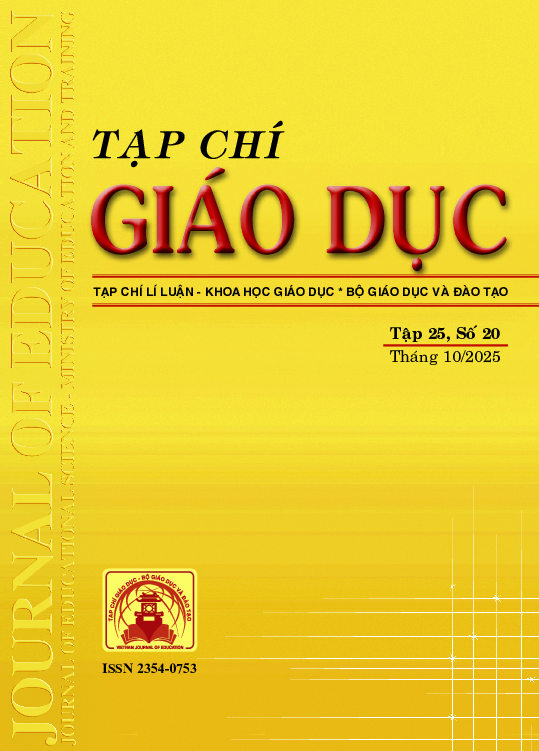Lí thuyết “ba thế giới toán học” và vận dụng trong dạy học một số khái niệm giải tích ở trung học phổ thông
Tóm tắt
In the context of global mathematics education, including Vietnam, shifting its focus toward developing students’ competencies and creative thinking, this study employs Tall’s (2004) Three Worlds of Mathematics (TWM) theory as a theoretical foundation to analyze the process of forming mathematical objects in students’ thinking. Based on this theory, we designed a sequence of instructional activities on the concept of the integral, structured across the embodied, symbolic and formal worlds. These activities were implemented with the support of GeoGebra to enhance visual experiences. The findings suggest that the TWM-based instructional model holds significant potential for supporting students in developing mathematical concepts in a wellgrounded manner, consistent with cognitive development processes and the competency-oriented goals of Vietnam’s 2018 General Education Curriculum.
Tài liệu tham khảo
Arnon, I., Cottrill, J., Dubinsky, E., Oktaç, A., Roa Fuentes, S., Trigueros, M., & Weller, K. (2014). APOS theory: A framework for research and curriculum development in mathematics education (1st ed.). Springer. https://doi.org/10.1007/978-1-4614-7966-6
Biggs, J., & Collis, K. (1982). Evaluating the quality of learning: The SOLO taxonomy. Academic Press.
Bruner, J. S. (1966). Towards a Theory of Instruction. New York: Norton.
Dienes, Z. P. (1960). Building Up Mathematics. London: Hutchinson.
Đỗ Đức Thái, Đỗ Tiến Đạt, Nguyễn Hoài Anh, Phạm Xuân Chung, Nguyễn Sơn Hà, Phạm Sỹ Nam (2016). Tài liệu tìm hiểu chương trình môn Toán (trong Chương trình giáo dục phổ thông 2018). https://dtbdtx.hnue.edu.vn/Portals/0/Tai%20lieu%20tim%20hieu%20chuong%20trinh%20mon%20Toan.pdf
Gray, E. M., & Tall, D. O. (1994). Duality, ambiguity, and flexibility: A “proceptual” view of simple arithmetic. Journal for Research in Mathematics Education, 25(2), 116-140. https://doi.org/10.2307/749505
Lakoff, G., & Núñez, R. E. (2000). Where mathematics comes from: How the embodied mind brings mathematics into being. Basic Books.
Piaget, J. (1965). The Child’s Conception of a Number. New York: Norton.
Phan Trọng Ngọ (chủ biên), Lê Minh Nguyệt (2016). Giáo trình các lí thuyết phát triển tâm lí người. NXB Đại học Sư phạm.
Sfard, A. (1991). On the dual nature of mathematical conceptions: Reflections on processes and objects as different sides of the same coin. Educational Studies in Mathematics, 22(1), 1-36. https://doi.org/10.1007/BF00302715
Tall, D. (2004). Introducing three worlds of mathematics. For the Learning of Mathematics, 23(3), 29-33.
Tall, D. (2014). How humans learn to think mathematically: Exploring the three worlds of mathematics. Cambridge University Press. https://doi.org/10.1017/CBO9781139565202
Tall, D., Gray, E. M., Bin Ali, M., Crowley, L., DeMarois, P., McGowen, M., Pitta, D., Pinto, M., Thomas, M., & Yusof, Y. (2001). Symbols and the bifurcation between procedural and conceptual thinking. Canadian Journal of Science, Mathematics and Technology Education, 1(1), 81-104. https://doi.org/10.1080/14926150109556452
Trần Kiêm Minh, Phạm Văn Tuân, Lê Thị Bạch Liên (2016). Lí thuyết ba thế giới toán học và vận dụng vào dạy học đạo hàm. Tạp chí Khoa học Giáo dục, 126, 13-16.
Van Hiele, P. M. (1985). Structure and insight: A theory of mathematics education. Academic Press Inc.
Tải xuống
Đã Xuất bản
Cách trích dẫn
Số
Chuyên mục
Giấy phép

Tác phẩm này được cấp phép theo Ghi nhận tác giả của Creative Commons Giấy phép quốc tế 4.0 .












